The Business Continuity Imperative: Experience Management across Business for Organizational Effectiveness in 2020 and Beyond
Over the past several months, I have discussed a wide range of topics that organizations must consider and appropriately prioritize to maintain business continuity during periods of upheaval. But sometimes it’s important to take a step back and reflect on a critical and recurring theme: experiences. The array of experiences across the workforce and business processes both inside and outside of the organization are an essential part of an organization’s success. Leadership must give these experiences the attention they deserve, and this requires visibility into operations and the tools to measure effectiveness, especially during black-swan events. Fulfilling this objective requires the programs, processes and technology designed to meet the needs of what is called experience management (XM).
Unfortunately, organizations far too often neglect the need for continuous and high-quality experiences. This is why Ventana Research asserts that through 2021, one-half of organizations will realize that digital transformation investments have not met the organizational readiness requirements of business continuity, leading to a new focus on innovative digital technologies that more reliably sustain operations.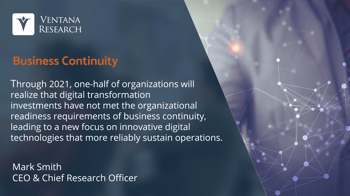
The business continuity imperative requires that organizations make it a priority to examine essential business and technology areas that are often overlooked in the physical and virtual workplace but that make a meaningful impact on the organizational objectives. Leadership must not just support execution of business processes but ensure high-quality experiences by optimizing how and where work is conducted with critical constituents — customers, partners and suppliers — to provide products or services.
Managing experiences in business processes is more difficult than it should be because existing applications are not designed to deliver the feedback and insights an organization needs to improve. Effective engagement to reach optimal outcomes requires a process that facilitates great experiences — that is, easy digital participation and collaboration for anyone involved with others in the organization.
To provide experiences that exceed expectations, organizations require information that’s easy to access and act upon to optimize results. The sustainability of every organization hinges on effective experiences and technology investments that enable an organization to maximize its potential.
Building Continuity with Experience Management
Every organization should start by assessing all short- and long-term needs related to managing experiences and business continuity for the entire organization that may already be in place. No matter how an organization manages its experiences to achieve agility and skills that ensure readiness, to maintain business continuity it must continuously ensure experiences are effective and impactful. This is nearly impossible to accomplish from a tangle of surveys, forms and spreadsheets.
Furthermore, organizations that haven’t yet unified experiences so that they’re managed in the cloud for continuous operations must make this an immediate priority. It’s difficult to maintain business continuity and do the optimization needed when experiences aren’t managed in a unified manner that ensures an acceptable level of resiliency.
Organizations should embrace a culture of seamless digital experiences that encourage engagement to bolster more collaborative interactions across people, processes and systems. Organizations that have a Voice of the Customer (VoC) and Voice of the Employee (VoE) program are well on their way to understanding and optimizing experiences. Streamlining experience management is critical for success and this is impossible without high-quality, seamless digital experiences. In fact, Ventana Research asserts that by 2022, one-half of organizations will determine that the digital experiences they provide are not intelligent or automated and fall short in maintaining business continuity for organizational readiness, resulting in lost customers and workforce instability. Organizations must create excellent experiences to build a strong, forward-looking and agile enterprise.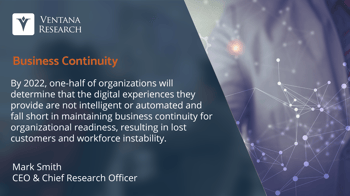
Success with business continuity is about more than just providing continuous electronic surveys, fishing for a better NPS score or assuming any one channel represents the totality of the experiences across an organization that can make a mistake when they manage from this vantage point alone. It’s not even about increasing levels of satisfaction and even sustaining those efforts in best and worst of times, under pressure and over time. Business success is about cultivating organizational readiness and ensuring that the organization has the agility to deliver expected outcomes.
Experience Management should do more than just optimize the flow of operations — it should guide a path toward excellence in everything that the organization is focused on accomplishing. It should provide business insights using critical metrics that indicate the future health of the organization as well as the readiness of those performing work. An integrated portfolio of managing experiences requires specialized analytics that can assess interactions, sentiment around them and feedback after the fact, whether speech or text, in real-time or over time. The analytics also should be able to provide historical performance that leadership can then use to understand variances and target improvements. Many organizations depend on analytics but metrics that lack context and a dashboard alone are insufficient. The real value comes from applying machine learning to analytics to uncover challenges and opportunities for optimizing experiences and provide immediate guidance on business process and interactions.
Machine-generated insights about the experience inside and to the outside of the organization must be easy to consume and use; some of the most accessible products use natural language and generate stories that can be read or heard and present the impact of potential plans in simple and actionable terms. The experience management system should be able to create effective notifications that place intelligence into the hands of the people involved the business process, not just after an interaction but in the moment when it matters.
The experience management system should be able to create effective notifications that place intelligence into the hands of the people involved the business process, not just after an interaction but in the moment when it matters.
I discussed this next generation of digital experiences in my recent perspective on how to use data and analytics to achieve organizational success. A strong focus on experiences can unify an organization’s efforts to not just sustain continuity but bring new value to business efforts. It’s more about optimizing engagement than administration. Optimizing experiences is more than just a nicety; it’s essential for every organization that looks to make the most of engagement and relationships across a workforce and with customers, partners and suppliers.
Maintaining business continuity during challenging times means that an organization has the flexibility to adapt organizational priorities and rapidly align plans to reach expected performance. This effort is important whether the work environment is from home or on the front lines of a pandemic; organizations should seek to provide experiences that go beyond what the enterprise expects. Without an optimized and continuous set of processes dedicated to experience management, an organization won’t be able to elevate performance and reach their ultimate potential; I recently discussed why this is a critical part of your mission for business continuity and beyond.
Digital Communications is Essential
Managing experiences requires not just the right applications but ones that enable collaborative digital communications so leaders can make good decisions. Challenges such as a global pandemic or natural disasters demand digital communication across a distributed and most likely virtualized workforce; however, crises often shift priorities and engagement can suffer.
Ventana Research asserts that through 2022, one-half of organizations will determine that their technology for unified communications is ineffective for meeting business continuity needs and falls short in the open communications requirements for secured and seamless interactions across devices and people. Organizations must ensure their digital communications 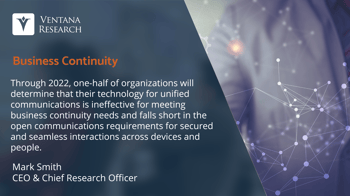 can interoperate with the necessary applications and provide frictionless digital experiences and sensible processes that ensure high levels of engagement where experiences occur. This collaboration might be best addressed through conversational computing methods such as intelligent virtual agents (IVAs), which are smarter than most bots. This technology can rapidly respond to individual needs and can also streamline responses to exceptions and issues that inevitably arise. IVA should enable the collection of feedback to understand individuals’ participation in a range of roles and responsibilities.
can interoperate with the necessary applications and provide frictionless digital experiences and sensible processes that ensure high levels of engagement where experiences occur. This collaboration might be best addressed through conversational computing methods such as intelligent virtual agents (IVAs), which are smarter than most bots. This technology can rapidly respond to individual needs and can also streamline responses to exceptions and issues that inevitably arise. IVA should enable the collection of feedback to understand individuals’ participation in a range of roles and responsibilities.
Engaging the workforce effectively requires that organizations examine virtual ways to optimize work management methods that best support business processes and experiences of those in the workforce. It’s important that an organization rally its digital communications efforts during a crisis such as a pandemic, because effectiveness in enhancing experience across business processes requires collaboration across the organization. To be effective, organizations should establish best practices and policies that guide improvement to business processes, enhancing virtual interactions with leaders and managers for business continuity. This includes the direct engagement with customers, partners and suppliers and with business leaders to manage contextual collaboration that helps achieve mutual objectives including those to manage experiences. And organizations must keep this axiom of business continuity in mind: Applications and systems for experience management must not just support digital communications but use it as part of managing experiences with the organization inside and outside of normal operations and in a secured manner.
Experiences Matter
Many organizations have managed the business processes that involve customers, marketing, operations, products, sales, subscribers and the supply chain across an array of business applications. However, few of these applications support a dedicated focus on optimizing experiences by providing an integrated and continuous toolset that can operate across a range of business processes for people inside and outside of the organization. A quality approach to managing experience requires the right technology, which currently we certainly don’t find in legacy feedback and survey tools, nor within ERP, CRM or CX suites of applications. Though the the “X” in CX stands for customer experience, both old and newer vendors have failed to provide the integrated and continuous approach for collecting and acting upon experiences that organizations require.
It’s important that an organization make investments in supporting experience management that use an automated and intelligent approach — in other words, simplifying tasks, collaboration and facilitating easy examination of scenarios and potential outcomes. The current movement in technology towards a common platform can satisfy these needs, optimizing engagement and enhancing operations across the organization. One such example that I have written about is the importance of a Voice of the Agent (VoA) program that focuses on meeting the needs of agents, whose mission is to provide a quality customer experience. We assert that by 2023, one-fifth of organizations will establish a voice-of-the-agent (VoA) program, enabling them to ascertain agent satisfaction through analysis of interactions with and feedback from customers. Success here demands active engagement across the organization to provide visibility and the agility to adapt and improve in a volatile market climate.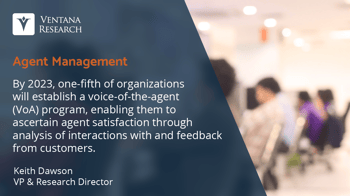
Organizations must improve experiences by assessing and prioritizing improvements to these processes to optimize engagement and readiness. Using the right technology is foundational to success and creates opportunities for breakthrough growth that far exceeds mere productivity improvements. The work-from-home and virtualized business efforts during a pandemic are a prime example of how most organizations were ill-prepared because business continuity planning was not a priority. Many organizations did not have the quantitative feedback on the needs and issues of the workforce, which is the foundation of human capital management (HCM) and for which I have outlined the steps to improvement.
Sustainable growth requires better experiences, which are only possible when an organization is deliberate about the technology it uses to work collaboratively across the organization to optimize them. Our research suggests that this need to collaborate will also require that organizations embrace more sophisticated forms of collaborative computing so that people across business processes can capture, share and analyze interactions to guide effective actions and decisions. For this reason, we assert that by 2023, one-half of organizations will shift from email to messaging-based collaboration; one-third of those also will adopt digital forums to capture knowledge and improve organizational competencies.
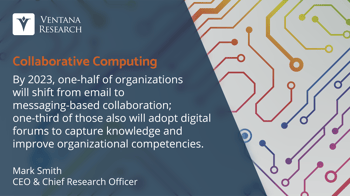 It is just as important in many industries to engage those outside the enterprise, particularly organizations across the supply chain, from suppliers, manufacturing and distribution partners to customers and partners. Organizations with a unified approach to experience management will find that it’s easier to achieve organizational agility when blended with digital communication platforms that are open and secure and that can help increase the velocity of engaging in and executing work.
It is just as important in many industries to engage those outside the enterprise, particularly organizations across the supply chain, from suppliers, manufacturing and distribution partners to customers and partners. Organizations with a unified approach to experience management will find that it’s easier to achieve organizational agility when blended with digital communication platforms that are open and secure and that can help increase the velocity of engaging in and executing work.
Organizations should also prioritize investments that enable more effective digital workforce experiences and therefore enhanced organizational readiness. Investments into dedicated applications for experience management is critical, especially during or following a pandemic, to ensure the continuity and engagement of the workforce. And clearly, organizations must be prepared to adapt and respond to business continuity priorities that can change in a daily basis. To do this organizations will need methods that use mobile devices to virtualize interactions with technology that supports workflow and robotic process automation (RPA) that can streamline to capture and provide feedback on experiences.
Smart Investments Matter
Organizations must consider whether investments in applications and technology support continuous visibility and optimization of experiences across the enterprise both inside and outside of corporate operations. It’s also critical that investments are built from a cloud-based experience management platform. Supporting these processes is significantly different than traditional survey or feedback procedures, which need not necessarily be continuous. The right technology includes a platform and applications that support the portfolio an organization needs across every line of business. Appropriate tools facilitate enterprise needs for a distributed — and during times of business continuity, virtualized — workforce and processes.
Investments should do more than automate survey participation but should provide value to everyone involved as well as support business continuity. And this is why we assert that through 2023, one-third of organizations will initiate business continuity planning to realign the priority of technology investments required to operate seamlessly in a distributed and virtual manner in customer, product, supply chain and workforce processes.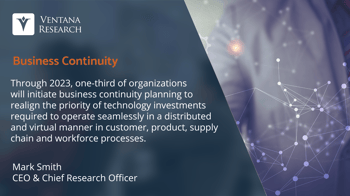
Smart investment requires an effective assessment of an array of applications and tools. A solid evaluation includes the following questions:
- Do your experience management technologies support the feedback and optimization needed for your enterprise across departments and processes?
- Do you have the experience management processes to optimize engagement and increase outcomes?
- Are you able to track and motivate feedback and provide insights to those engaged in business processes during a pandemic?
- Are you able to get feedback across channels such as phone, text and an IVA to gain immediate insight into needs and issues?
- Is your organization ready to manage engagement and measure how experiences impact performance?
- Can you assess the quality of interactions from text and voice across any channels to determine levels of experiences being provided?
- Are you able to have digital communications across the business process and experiences in the organization — and in a secured and governed manner?
- Can you integrate the external feedback from customers, partners and suppliers in a consistent manner that can identify challenges and issues inside the organization?
- Do you have the analytics and predictive indicators for experiences that are dynamically generated from machine learning?
- Are you able to collaborate about experiences in business process and garner structured feedback for optimizing engagement?
A “no” answer to any of these questions indicates risk that could directly impact an organization’s potential with its experience management efforts. Every organization – no matter the industry, the number of its employees or the size – has an opportunity to significantly improve its continuous processes and provide excellent digital experiences.
It’s critical that applications enable leaders and managers to adequately plan for and respond to needed changes, from black-swan events to meeting typical business continuity obligations. Organizations are unwise to even consider any investments that aren’t mobile-ready and powered with collaboration methods across the organization. We assert that by 2022, one-third of organizations will determine that their business applications are not suited to support their business continuity needs due to ineffective collaborative and mobile experiences, which are essential to operate seamlessly in a virtual environment.
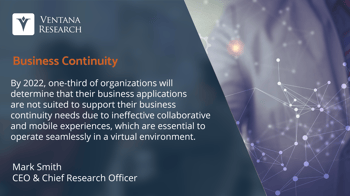 Every organization must ensure it have applications directly or can be embedded to operate on a mobile device and in a remote location, including from the couch and home office, so it can effortlessly capture feedback Organizations should be ruthless about any operation that is not being monitored and assessed for optimal digital experiences. While organizations have spent significant resources and efforts on digital transformation in the form of automation and efficiency improvements, a far more important consideration is whether those investments make a meaningful impact and can support a focus on organizational readiness and agility; adapting the workforce so it can achieve best possible experiences.
Every organization must ensure it have applications directly or can be embedded to operate on a mobile device and in a remote location, including from the couch and home office, so it can effortlessly capture feedback Organizations should be ruthless about any operation that is not being monitored and assessed for optimal digital experiences. While organizations have spent significant resources and efforts on digital transformation in the form of automation and efficiency improvements, a far more important consideration is whether those investments make a meaningful impact and can support a focus on organizational readiness and agility; adapting the workforce so it can achieve best possible experiences.
Partner with Business Leaders
The importance of teamwork among business leaders cannot be overstated when it comes to experience management and developing agility and responsiveness across the entire organization and its associated business processes. Optimizing processes where experiences occur is typically focused on the customer, which might be managed by the Chief Customer Officer (CCO). Those in this role are tasked with looking at the potential performance challenges and readiness of the organization to shift and meet customer objectives. Smart leaders in business have developed models to assess any risk variables that can impact the organization’s ability to reach its objectives, including the critical objective of business continuity.
A successful experience-focused organization goes further, embracing collaborative and continuous operations in all aspects of its business, including agents, customers, employees, partners, products, sales, suppliers and overall operations, all of which are contribute to the health and performance of the business. A focus on Experience Management is the foundation of both executive and operational leadership but cultivating a direct relationship with the entire organization — which actually performs the work across business processes — is just as important for ensuring business continuity. Thus, the new role of a Chief Experience Officer’s role is to work across the entire business to create superior experiences for everyone involved with the organization.
A successful experience-focused organization goes further, embracing collaborative and continuous operations in all aspects of its business, including agents, customers, employees, partners, products, sales, suppliers and overall operations, all of which are contribute to the health and performance of the business.
The business leadership need to actively support working closely with their business leaders who manage the business processes and examine how to engage and improve experiences. Success requires effective engagement, not just fulfilling and responding to the requests but operational efficiency. Similarly, legacy investments into surveys to knit together a view of experiences and the processes that support them are don’t provide sufficient visibility into organizational readiness.
Unfortunately, business leaders might not always be a partner, but this can be addressed through executive dialogue on business continuity to establish a clear understanding of the risks of not achieving expected outcomes. Business must lead and not be satisfied with just using surveys from employees and customers to support their needs. One example is partnering with heads of sales to examine if the selling experience is optimized and effectiveness. Dialogue with buyers and customers is a critical aspect of sales effectiveness, so understanding interactions and measuring sentiment can help sales professional achieve optimal outcomes.
Technology vendors that provide Voice of Customer or Employee approaches have not done a great job marketing and selling their offering beyond articulating how they help business leaders in their respective areas and across the organization. Many of these vendors’ websites lack depth and connection to the lines of business and processes, thus needs often go unmet. This should not be an impediment for business, but an opportunity to help leadership develop a common approach that unifies their efforts with a common platform and applications that optimize across all peoples’ roles, the related processes and any external constituents with a common experience to maximize engagement.
And of course, this effort should include continuous experience management that helps model and benchmark all aspects of the experience, especially the ones that address the broader needs of specific workforce roles and the connection to customers, partners and suppliers. By establishing a baseline of what you should have in an Experience Index (XI), through applying analytics and models, an internal benchmark can guide improvements across the specific areas. The ability to establish solid benchmarks can help foster the path to building a business case for investment. Executive teams and even boards of directors are responsible for ensuring that investments into these organizational processes will support current and future needs.
Next Steps
In times of crisis such as the current global health pandemic, when business continuity is a top priority, organizations mustn’t neglect digital investments into managing experiences, especially if it has not previously been a focal point of executive leadership or a team involved with these processes. A superior experience demands technology that can improve processes, productivity and the overall digital effectiveness of the business. Leadership that invests in managing experiences and related processes can have a profound impact on engagement and an organization’s ability to reach expected levels of responsiveness and performance.
Ensuring optimal experiences is a shared responsibility across the entire business, and is impossible to do without leadership designed to optimize the engagement both inside and outside of the organization. This approach is not about technology for just feedback but providing insights that guide the actual engagement and interactions with the enterprise to meet their business needs. It’s about a dedicated approach that’s focused on the experiences and processes related to the specific areas of the business that includes agents, customers, employees, marketing, partners, products, sales, subscribers, suppliers, and relevant areas and processes unique to your industry. Even a focus on experiences with products, via digital or physical, are part of the mission to experience management and should be swiftly addressed.
Antiquated methods such as one-off extensions to conduct surveys and place results in a dashboard are not designed for understanding one type of interaction beyond customer and employee feedback. Moreover, effective management of experiences requires far more than just the administration and tracking of surveys and they certainly don’t provide modern digital methods to understand and optimize experience. One-off technology approaches can also decrease productivity, diminish accountability and increase risk in not having a comprehensive enterprise-wide approach to experience management. It is critical that organizations, especially in times of duress, use business continuity as a driver to engage the business through the intelligent use of dedicated platform and systems, and thus should examine their investments in technologies.
If you are not sure how to approach improving the digital aspects of your business needs and the focus on the experience — and thus engagement and outcomes — through the lens of business continuity, there are specific steps that every organization should take, similar to the steps outlined in my perspective on the imperative for digital innovation in business continuity. The effective use of digital technologies can reinvent experiences — for every participant no matter their relationship with the organization — requiring the right lens for a more comprehensive approach to support business continuity and not distract from it. Most organizations have realized this and are making it a priority to be more prepared. We assert that by 2022, after a decade of concerted efforts in digital transformation, one-half of organizations will not have established business continuity as an investment priority and will not be prepared to operate in a future pandemic or crisis, which will lead to increased operational risks.
To achieve business continuity, optimize underlying processes to embrace experience management and the dedicated applications for business-wide efforts and your organization. This can have an immediate impact on top- and bottom-line results and reflects the priority you place on your experiences. Once your organization has an effective approach then ensure that the digitally secure and open communications, along with the right unified tools – the collaboration is an essential part in delivering an optimal experience – you can be assured that your organization is built to last. Ensure that existing and future application investments are designed for effective engagement and a fantastic work experience, not just for automation and efficiency. The experience is much more than just the digital or the user experience (UX) of your existing applications but the ones that are designed for how the process and interactions between people operate.
Every experience matters, including the internal ones in your organization dedicated to all people and processes. The entire executive team — the CEO’s staff, the CMO, CFO, CIO, CCO, COO, CRO, CPO, and the Chief Digital or Innovation Officers— should be aware of the strategy and plans for optimizing experiences. They should look to a new CXO called the chief experience officer, who is focused on optimizing people and processes for future performance through increased effectiveness. Organizational leadership needs to ensure they embrace the discipline it entails. The future depends on the active involvement of those who see building sustainable experiences as fundamental to business continuity as well as the agility and readiness of the entire workforce.
Determining your path forward for 2020 and beyond requires an effective strategy that sustains business continuity and exceeds expectations. Make sure you are using applications and a platform that can truly provide an optimal digital experience that’s focused on organizational effectiveness through readiness and engagement, and sustainable long-term relationships.
Regards,
Mark
Authors:

Mark Smith
Partner, Head of Software Research
Mark Smith is the Partner, Head of Software Research at ISG and Ventana Research leading the global market agenda as a subject matter expert in digital business and enterprise software. Mark is a digital technology enthusiast using market research and insights to educate and inspire enterprises, software and service providers.










